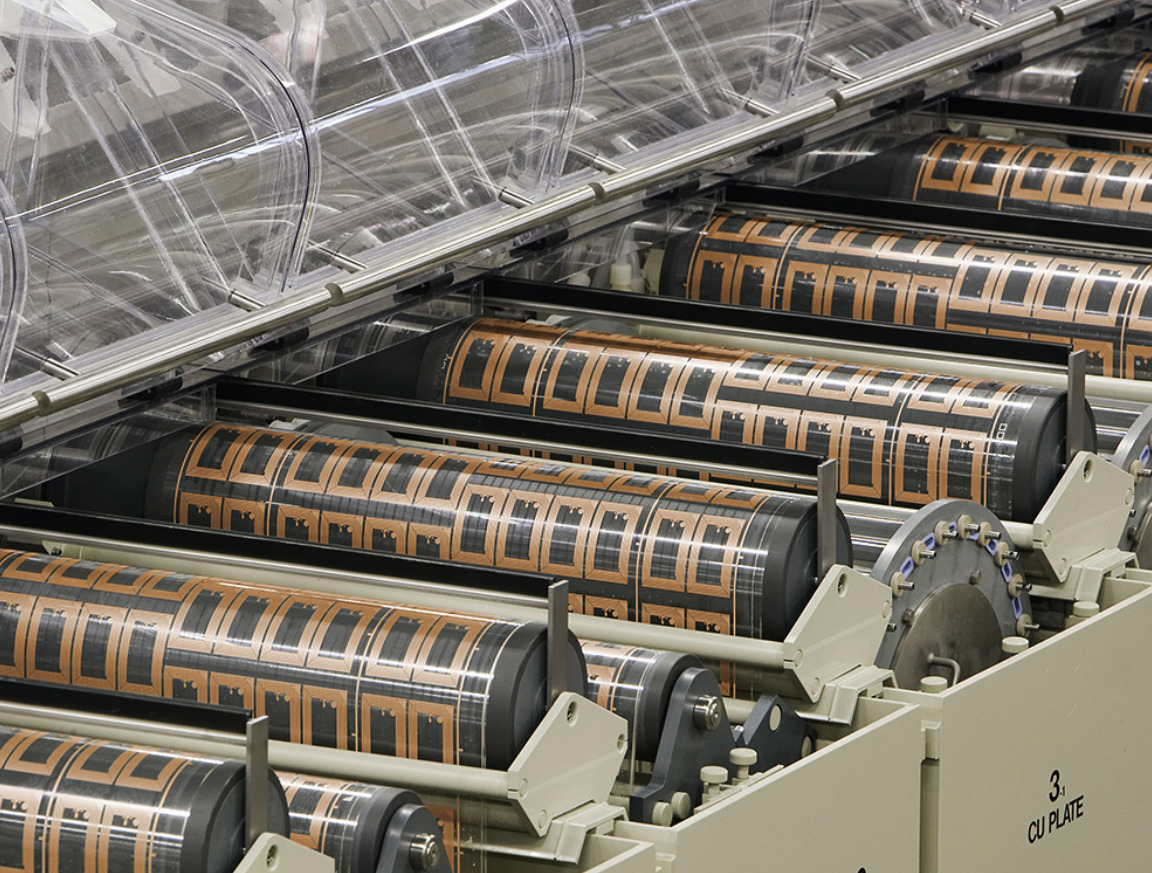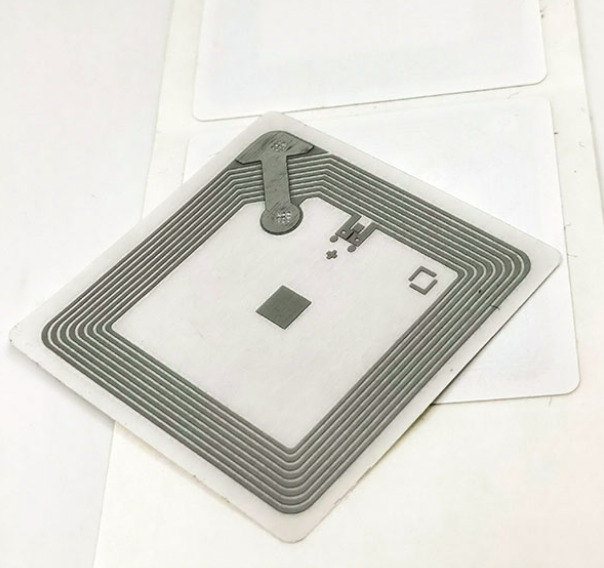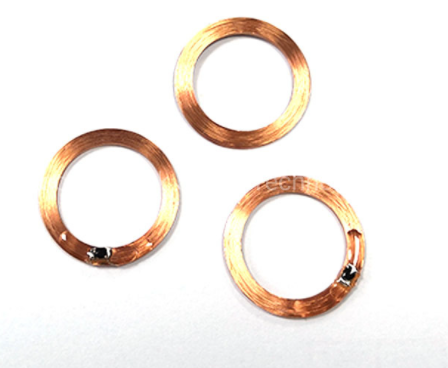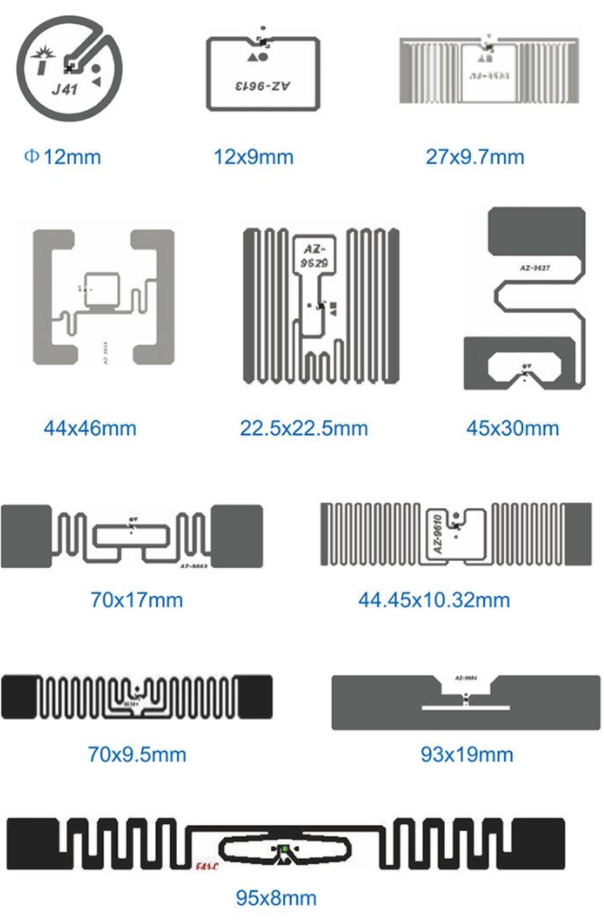So today, I will take you to understand the three most common RFID tag manufacturing processes.

RFID tag antenna manufacturing
RFID Antenna Etching Process
The first process we are going to introduce today is called the etching antenna process. This production process has a very long history of making antennas. With the advent of high-frequency and ultra-high-frequency antennas, it developes to the technology still in use today.
How to make an etched antenna:
First, a base material with a thickness of 0.1 mm is made. You can imagine making a dense film out of copper or aluminum. Then, take another sheet and paint the positive image (the mirror image of the antenna) with anti-corrosion agent. Subsequently, when this anti-corrosion “stamp” is printed on the board. The desired antenna position on the board is covered with anti-corrosion agent. Then, the entire plate covered with the anti-corrosion agent is immersed in a corrosive solution capable of dissolving the metal. You can see that parts of the metal are coated with a wax that cannot be corroded. Obviously, when the substrate is taken out from the etching solution. The parts that were not coated with the anti-corrosion agent were dissolved. Then wash off the anti-corrosion agent, and we get the RFID antenna in the shape we need.

RFID HF Antenna
The advantage of the antenna made by this process is that the material of the antenna will be denser and finer. Because the material of the antenna is the metal plate itself. The shortcomings are also easy to see. That is the higher cost. Moreover, the use of corrosive liquid will retain a large amount of industrial wastewater. Although wastewater can also evolutionary reused. But obviously it will consume more energy and pollute the environment.
RFID Antenna Printing Process
The second method,
It is called the printed antenna process. As the name implies, the printing antenna process is to print the antenna on the required substrate surface by printing. Today, the antenna we print in this way is much cheaper than the etching process. Because, compared to the etching process. There is no large amount of metal and corrosive liquid that wasted. The method and process are also relatively simple. In the current environment, the printing process has become a relatively mainstream production process.
So why didn’t we use this type of printing a lot before? It’s actually quite understandable. Because the technology of printing silver paste has been gradually improved in recent years. After all, the printed antenna is not as thick as the original substrate antenna. And the previous printed antenna technology is not mature. This makes the performance of printed antennas less stable than etched ones.
With the development of technology, the process of printing antenna is quite mature now. The performance of the printed antenna is also very similar to the performance of the etched antenna. And, in the past few years, in addition to the vigorous development of silver paste printing technology. There have also been many alternatives to silver paste, copper and aluminum. Such as graphene materials. Now, a large number of RFID manufacturers. Including RFIDHY, can make graphene antennas by printing. Graphene conducts electricity very well and costs less. This makes graphene antennas a new star in RFID antennas.

RFID LF antenna
RFID antenna winding process
The two RFID antenna production processes we talked about before are mainly used in the production of high-frequency and ultra-high-frequency antennas. So for low-frequency antennas, most of the time. We still use the winding process. The winding is to use a winding machine to wind the shape of the antenna.
How to distinguish low frequency, high frequency and ultra high frequency antenna
Low-frequency antennas are often in the shape of a circle wound by a winding machine. And high-frequency antennas are more thin circular or rectangular, similar to such a regular shape. UHF is irregular axisymmetric jagged. UHF tags need read over long distances. Therefore, the antennas are often specially designed, and most antennas are irregularly shaped.

RFID UHF antenna
Characteristics of different frequency tags
Through the above description, I believe that everyone has not only learned about the various manufacturing processes of the antenna. Also learned how to identify low frequency, high frequency and ultra high frequency tags.
The read distance of low frequency tags is generally between five millimeters and twenty centimeters. They are cheap and less prone to breakage. But the security encryption is poor. However, general company access control punch cards and other fields do not require high security and encryption.
The confidentiality of high-frequency antennas is very good. They can use high-level encryption technology, and the read and write distances are often very close. The reading distance is not good, you don’t want your bank card to be stolen, do you? High-frequency tags generally have a reading distance of one or two centimeters. And the NFC tag we are familiar with, Near Field Communication. This is a kind of near-field read-write protocol tag in popular terms. They also belong to the category of high frequency tags.
What about UHF tags? Their individual distances can reach 2 to 8 meters or more. UHF tags can be used in areas such as asset management and inventory counts. In addition to encryption, batch reading and writing is also a major feature of UHF tags. It is thanks to the ultra-high frequency reading and writing technology. That it is possible to register thousands of goods in one second.
Key words: RFID antenna asset management RFID antenna manufacture RFID tag
Written by: Li Shijun
Shanghai RFIDHY Technology Co., Ltd.
Please indicate the source





